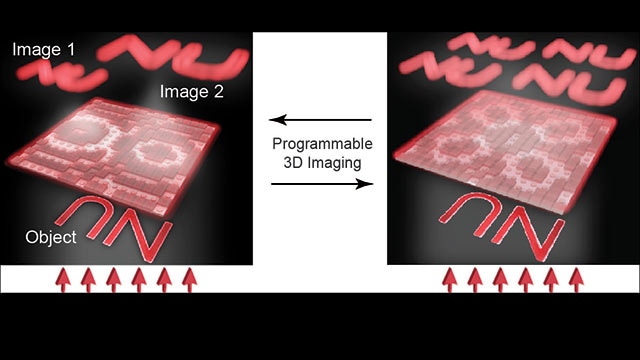Mar 29 2019
A research team at Northwestern University has created tiny optical elements from metal nanoparticles and a polymer that soon might replace traditional refractive lenses to realize portable optoelectronic devices and imaging systems.
 During a single imaging session, the device can evolve from a single-focus lens to a multi-focal lens that can produce more than one image at any programmable 3D position. (Image credit: Northwestern University)
During a single imaging session, the device can evolve from a single-focus lens to a multi-focal lens that can produce more than one image at any programmable 3D position. (Image credit: Northwestern University)
Compared to the width of a human hair, the flat and versatile lens, a kind of metalens, has a thickness that is 100 times smaller.
“This miniaturization and integration with detectors offers promise for high-resolution imaging in devices from small wide-angle cameras to miniature endoscopes,” said Teri W. Odom, who led the study. She is the Charles E. and Emma H. Morrison Professor of Chemistry in the Weinberg College of Arts and Sciences and chair of the department of chemistry.
The properties of metalenses rely on the rationally engineered setup of nanoscale units. Metalenses have materialized as a smart option for flat lenses but are presently restricted by their static, as-fabricated properties and their intricate and expensive fabrication.
For imaging processes such as focusing and zooming, however, the majority of metalenses cannot alter their focal spots without physical motion. One key reason, Odom said, is that the building blocks of these lenses are composed of hard materials that cannot alter shape once built. It is tough for any materials systems to alter nanoscale-sized features directly to get tunable focusing in metalenses.
“In this study, we demonstrated a versatile imaging platform based on fully reconfigurable metalenses made from silver nanoparticles,” said Odom, a member of Northwestern’s International Institute for Nanotechnology. “During a single imaging session, our metalens device can evolve from a single-focus lens to a multi-focal lens that can form more than one image at any programmable 3D position.”
The research paper, titled “Lattice-Resonance Metalenses for Fully Reconfigurable Imaging,” was published by the journal ACS Nano recently.
The Northwestern team constructed their lenses from an assortment of cylindrical silver nanoparticles and a layer of polymer patterned into blocks on top of the metal array. By just manipulating the arrangement of the polymer patterns, the nanoparticle array could direct visible light to any fixed focal points without requiring a change to the nanoparticle structures.
This scalable technique allows various lens structures to be created in a single step of erasing and writing, with no obvious degradation in nanoscale features after numerous erase-and-write cycles. The method can reshape any pre-formed polymer pattern into any preferred pattern using soft masks made from elastomers.
The study was aided by the Vannevar Bush Faculty Fellowship from the Department of Defense (grant no. N00014-17-1-3023) and the Air Force Research Laboratory (agreement number FA8650-15-2-5518).